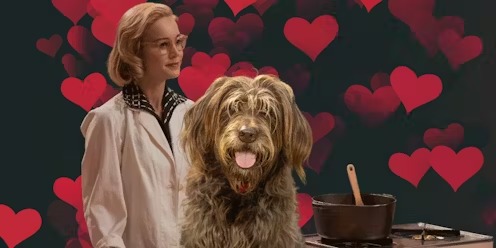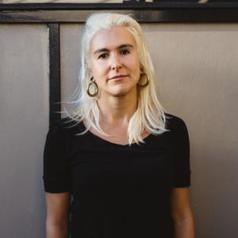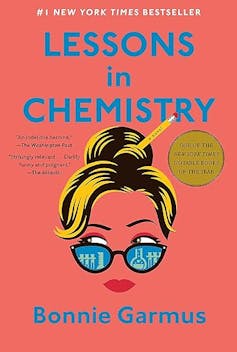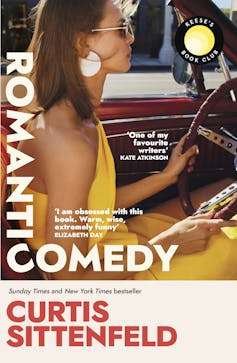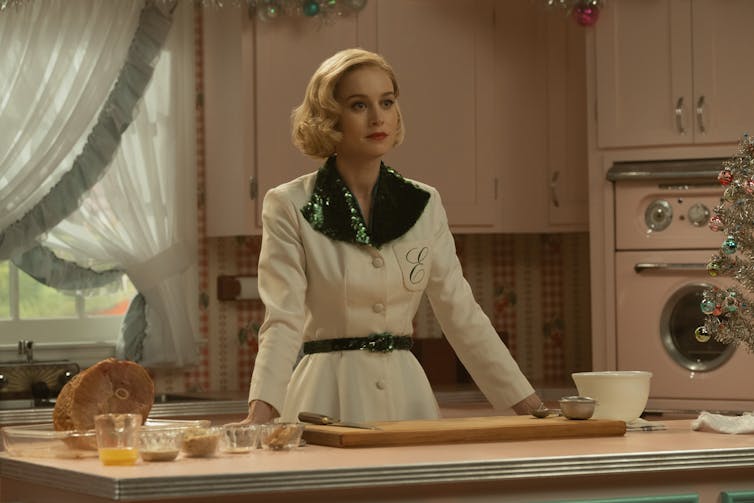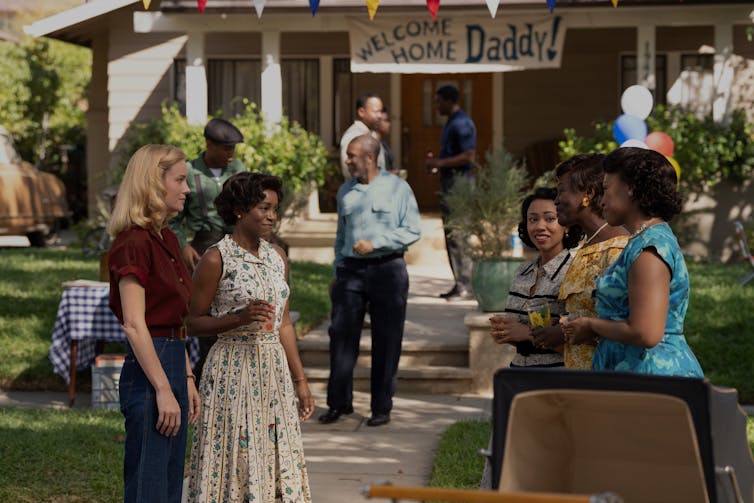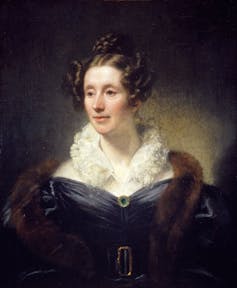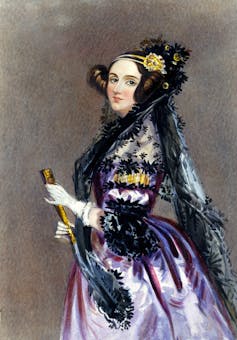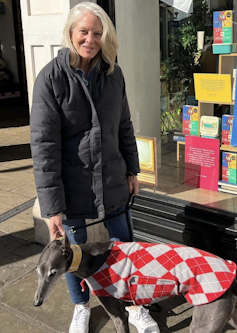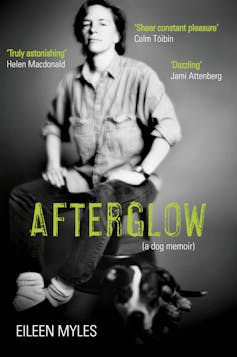If you were charmed by the Apple TV+ adaptation of Bonnie Garmus’s debut novel Lessons In Chemistry and want learn more about the book, the first thing you’ll discover is that it was a New York Times bestseller (for more than 58 weeks) and international hit, with a #BookTok following and rights sold to 40 countries.
US cover.
The second is that some American readers were angry about the cover because the pink jacket with the sexy illustrated book face – all flippy hair, pouty lips and cat-eye glasses – implies a sassy romance the story does not deliver. Garmus even received hate mail. “They were like, ‘You’re the worst romance novelist ever’,” she told the New York Times.
That North American publishers know a cover with a sexy, flippy-haired cartoon gal is more likely to sell a book than, say, one with a photograph of a serious-looking woman working in a laboratory, aligns ironically with the social truths Garmus investigates.
What kinds of stories, Garmus asks in her novel, do we pay attention to? And whose interests will our attention serve? Given the cover controversy, these questions can be extended to genre, too. What do our expectations around genre do to our reading? What is the difference, for instance, in reading a novel as a romance, popular fiction or feminist allegory?
Subverting romance fiction
In part, this is a commercial question. Genre provides a taxonomy for comparing texts, as well as strategies to sell them. Romance, of course, is a billion-dollar industry.
In 2021, the genre accounted for 18% of fiction sales in the US, according to one source. And its popularity is on the rise while overall book sales decline: in the past year (in the US), romance book sales have grown by 52%.
Readers of romance expect narratives featuring smart, pretty female protagonists who live, laugh, love without too much rumination on structural oppression. Romance is a feel-good, aspirational genre – which is not to say innovation isn’t valued.
Recently, Curtis Sittenfield’s Romantic Comedy, which questions why it’s socially acceptable for ordinary-looking men to date goddesses, but not the other way round, performed and critiqued the genre, while looking at how gender biases dominate our real lives and the ways we represent them. In You Have Made a Fool of Death With Your Beauty, Akwaeke Emezi imagines the possibilities of a second-chance romance that refuses to overwrite the complexities of past trauma and grief. But both of these writers stay true to the first command of romance: the lovers live happily ever after.
Against the opinion of irate North American readers, I contend it’s possible to read Bonnie Garmus’s Lessons In Chemistry as a subversive romance novel.
Protagonist Elizabeth Zott is pretty and smart. She falls in love. She struggles toward a hopeful conclusion. But if Garmus rocks the love boat, it’s in her refusal to let romantic love conquer all. Particularly when “all” is entrenched capitalist patriarchy.
Further, she refuses to romanticise the experience of being a woman, even a woman in love. Fairy tales are left in the library. Garmus’s protagonist clings to a very basic desire: to live a self-determined life in contexts that insist women shouldn’t determine anything for themselves, least of all their lives.
If Garmus rocks the love boat, it’s in her refusal to let romantic love conquer all. Apple TV+
Lessons in Chemistry
Lessons in Chemistry opens in 1961. Elizabeth Zott is a 31-year-old single mother, certain her life is over. The particulars of that life are revealed gradually.
Zott grew up with pseudo-religion. Her father, a charlatan preacher, introduced her to chemistry by using pistachio nuts to “conjure a spontaneous combustion whenever he needed a convenient sign from God”. Zott and her brother found sanctuary from the “sanctuary business” in the rational church of the library. They sheltered from a social milieu that would not accept them for who they were: he a homosexual, and she a scientist.
Garmus’s positioning of “scientist” as an intrinsic identity – as maligned in a woman as homosexuality – draws reader attention to the work several generations of women did in the workplace, and in areas of knowledge production that excluded their perspectives.
Lessons in Chemistry reveals the particulars of its heroine’s life gradually.
In interviews, Garmus has attributed the novel’s genesis to the experience of a male colleague blatantly taking credit for her ideas at work. She has the adult Zott set up a freelance business, doing her former male colleagues’ work without any credit for it. And she dedicates the book to her grandmother. The world may have changed, the novel suggests, but there are aspects of the fight that remain the same.
When Zott fights patriarchy, the cultural monolith conveniently takes the form of a singular enemy – a lecherous colleague, a rapist, a power hungry middle manager – which Garmus’s clever writing allows her protagonist to meet head-on with violence. Not sexy, sassy violence either. That pencil tucked provocatively into her chignon on the US cover: it’s sharp, a weapon both figuratively and literally. Zott writes up research findings and fights off rapists with it. The catharsis of such pointed retaliation is undeniable.
Lessons in Chemistry relieves readers of the complexities of post-#MeToo discourse and evokes something akin to feminist nostalgia for clear and obvious enemies. Race, though, is not explicitly addressed in the novel, an oversight the TV adaptation will attempt to address.
When Zott gets a dubious break as a TV anchor on a cooking show, she subverts the format, calling common ingredients by their chemical names and embedding feminist messages in the cooking instructions.
Race is not explicitly addressed in the novel, an oversight the TV adaptation will attempt to address. Apple TV+
She’s deemed unmarketable, despite her rising popularity with female viewers. A cover article in Life magazine runs with the headline, “Why We’ll Eat Whatever She Dishes Out”, and opens with a quote about Zott being “the most intelligent person on television today, except the editor had swapped out ‘intelligent’ and replaced it with ‘attractive’”. When the reporter later tries to make amends by penning an article on gender bias in science, he is rejected by ten scientific magazines.
“Women in science isn’t something people have any interest in,” Zott tells her neighbour – without flicking her hair, chewing on her pencil, or pushing her glasses down to stare dreamily at a man she might love.
Women of science
Zott’s love story contains more than one scene where the female protagonist needs to patiently explain sexism to her male beloved – a trope of real-life heteronormative romance, as many heroines can attest. When Zott’s beloved, a revered male scientist named Calvin, claims sex discrimination in the sciences isn’t real, Zott asks, patiently, if he can name any woman scientists.
“Do not say Marie Curie,” she adds.
It’s an example of Garmus’s playful prompts for readers to consider the stories we do not know. Not just the fun alternative histories, but the real ones, too.
The term ‘scientist’ was coined in 1834, in an article on Mary Somerville (pictured). Wikipedia
After all, the term “scientist” was coined in 1834 in an article on Mary Somerville, a Scottish polymath whose published books covered her primary field of mathematics, as well as astronomy, geology, chemistry and physics “so clearly that the texts became the backbone of Cambridge University’s first science curriculum”. The term “scientist” was necessary both to encompass Somerville’s interdisciplinary work, and because “man of science” did not apply.
Ada Lovelace. Wikipedia
Somerville tutored Ada Lovelace, the first computer programmer, and was but one of a truncated lineage of female scientists, including Lise Meitner, who co-discovered nuclear fission in 1938, Rosalind Franklin, whose 1950s research identified key properties in DNA and facilitated the correct description of the double helix, Jocelyn Bell Burnell, who discovered radio pulsars in 1967, and Vera Rubin, whose research in the 1970s confirmed the existence of dark matter.
Reading about each of these women’s careers, one encounters enough repeated plot points to constitute a genre. Each woman was excluded from research teams, expelled from prestigious colleges due to disagreements with male colleagues, and/or overlooked by Nobel Prize committees.
An alternative cover for Lessons in Chemistry might represent the determined face of Elizabeth Zott, composed of tiny images of her equally determined and frustrated historical peers. Of course, few of us would recognise them.
A good dog: ‘the real Prince Charming’
It’s lucky then, that I never paid any attention to the cover of Lessons in Chemistry. I’m a “pragmatist” and a “scholar”: that is, I like to pretend I do not enjoy romance novels. I do not generally admit to enjoying any books with flippy-haired women on the cover.
I am a “serious” reader. Self-styled above the middlebrow, refusing any gender-tag. As such, I picked up Lessons in Chemistry for one reason only: I heard there was a very good dog in it.
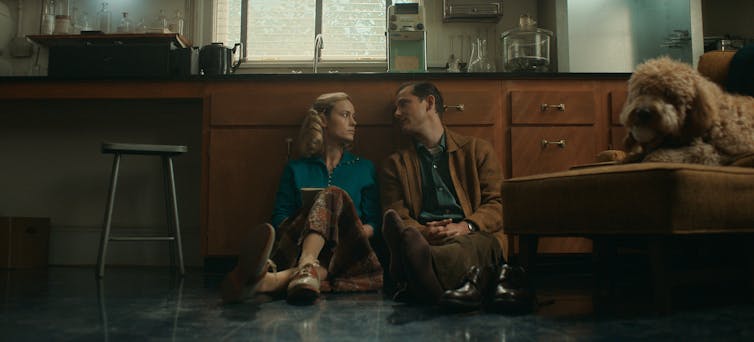
‘I picked up Lessons in Chemistry for one reason only: I heard there was a very good dog in it,’ says Briohny Doyle. Apple TV+
Very good dogs transcend literary genre. Karenin from Milan Kundera’s The Unbearable Lightness of Being is as important to literature as Jack London’s White Fang, Eileen Myles’ dearly departed Rosie, and Laura-Jean McKay’s dingo, Sue, in The Animals in That Country.
In novels, dogs demonstrate humane behaviour. Literary dogs are keenly attuned to the absurd, and to suffering. If, as Jeremy Bentham wrote, the proof of animal sentience is a capacity to suffer, in literature, the very good dog suffers with, for, and because of its human counterparts.
Elizabeth Zott finds her good dog, Six-Thirty – who narrates sections of the novel – at 6:30pm in an alleyway at the back of a local deli. The mangy animal lay hopeless and on his last legs until she appeared, at which point he “took one look at her, pulled himself up, and followed”.
He is ready to live, learn and suffer with her. In fact, if we are to read the novel as subversive romance, this dog might be the real Prince Charming. Theirs is a clear case of respect at first sight. Dog and scientist recognise something ineffable in each other, are bound, will never part.
Six-Thirty supports Zott through grief, labour and child-raising. He’s keenly attuned to their co-dependency. The emotional commitment of each keeps the other alive, he observes ruefully, exhausted by the “mess” that is “devotion”.
Zott, whose continually unmet demand for recognition gives her pause to recognise others, sees Six-Thirty for the perspicacious mongrel he is. She reads aloud to him, choosing stories she thinks he’ll enjoy. Like Moby-Dick: “a story about how humans continually underestimate other life-forms. At their peril.”
What Zott doesn’t know is that Six-Thirty is as acculturated an animal as she is. Trained as a bomb-sniffing dog, his decent into the vulnerable position of “stray” is a direct result of a fatal flaw: Six-thirty is gun shy. That is, just like Elizabeth, his intellect is more nuanced than his training allows.
The very good dog and woman scientist are not just emotionally bonded, but a chemically coefficient combination for a multi-species feminist romance.
Bonnie Garmus with her dog, 99. Agregory/Wikipedia, CC BY
In the novel, Six-Thirty is as smart as he is ugly. He’s tall, grey, thin and covered in “barbed-wire-like-fur that made him look as if he’d barely survived electrocution”. In the Apple TV adaptation, he appears to be a caramel-coloured labradoodle. So it goes. No one is safe from the glamour-washing of commercial media.
Novels – like Moby-Dick – that include significant animal characters also explore the ways power determines who speaks and who is silent. An animal narrator can be a foil to human behaviour, denaturalising the ideological underpinning of the story world. An animal familiar can also demonstrate true humanity.
Although novels with animal characters seldom circumvent the problem of anthropomorphism, they highlight the limitations of our systems of representation. Non-human animals point out the nonsense in the human animals’ sense of the world.
Six-Thirty smells the onset of Zott’s impending labour, her death wish as she grieves, and communicates with her foetus in utero. But he still grapples with the idea he’s a “smart dog”. “The word seemed to have as many definitions as there were species, and yet humans […] seemed only to recognise ‘smart’ if and when it played by their own rules,” he observes.
Eileen Myles imagines in Afterglow: a Dog Memoir, that every dog needs to find a writer to tell their story. If that’s true, in Bonnie Garmus’s novel, Six-Thirty might need a scientist to record the truth: we are all capable of surprising each other.
We can never know each other’s capacities, particularly through the prism of our preconceptions. To understand anything and anyone, you have to pay attention – while also holding your assumptions up to critical scrutiny.
Bad romance
In Garmus’s bad romance, the clichés of love are rebutted. No emotional state will appear on the horizon and save your life. If there are fireworks, it might be a chemical reaction caused by pistachio nuts. And if there’s conquering to do, you’d better roll up your sleeves and get to work.
Instead of a happy bride at an altar, Garmus gives the reader the image of a grieving, pregnant, unemployed woman doggedly fighting an invisible tide on a home-made rowing machine.
There are, as promised, lessons in Garmus’s novel, though they belong more in sociology than chemistry. Community, integrity and determination pull Zott through tragedy toward a hopeful ending. Love is primarily about co-responsibility. If you can’t have a family of origin, or a Prince Charming, you can have a chosen family.
Romance fiction is defined primarily by two key features – a central love story, and a hopeful ending – though scholars of the genre identify hope, rather than love, as the dominant thematic concern.
As a serious reader, and a woman who has loved and lost, I flip my hair and raise my brows over my glasses at the false hope of happily-ever-after. Elizabeth Zott, and her creator, Bonnie Garmus would feel the same.
Of course love can change the world for the better. It also tears us apart. Happy endings are cheap, and seldom conclusive. Meanwhile, on the pragmatic side of romance, a woman scientist – having thought her own life over – picks up her pencil and returns, with renewed commitment, to her research questions about the wider world.



 Squid Game Finale Boosts Netflix Earnings, But Guidance Disappoints Investors
Squid Game Finale Boosts Netflix Earnings, But Guidance Disappoints Investors  Trump-Inspired Cantonese Opera Brings Laughter and Political Satire to Hong Kong
Trump-Inspired Cantonese Opera Brings Laughter and Political Satire to Hong Kong  Netflix’s Bid for Warner Bros Discovery Aims to Cut Streaming Costs and Reshape the Industry
Netflix’s Bid for Warner Bros Discovery Aims to Cut Streaming Costs and Reshape the Industry  Trump–Kushner Links Raise Concerns as Paramount Pushes $108B Warner Bros Discovery Bid
Trump–Kushner Links Raise Concerns as Paramount Pushes $108B Warner Bros Discovery Bid  Disney’s Streaming Growth Hinges on International Expansion and Local Content
Disney’s Streaming Growth Hinges on International Expansion and Local Content  Trump Threatens Legal Action Against Disney’s ABC Over Jimmy Kimmel’s Return
Trump Threatens Legal Action Against Disney’s ABC Over Jimmy Kimmel’s Return  Oscars 2025: who will likely win, who should win, and who barely deserves to be there
Oscars 2025: who will likely win, who should win, and who barely deserves to be there  How Marvel’s Fantastic Four discovered the human in the superhuman
How Marvel’s Fantastic Four discovered the human in the superhuman  The quest to extend human life is both fascinating and fraught with moral peril
The quest to extend human life is both fascinating and fraught with moral peril  FCC Chair Brendan Carr to Testify Before Senate Commerce Committee Amid Disney-ABC Controversy
FCC Chair Brendan Carr to Testify Before Senate Commerce Committee Amid Disney-ABC Controversy  Mexico Probes Miss Universe President Raul Rocha Over Alleged Criminal Links
Mexico Probes Miss Universe President Raul Rocha Over Alleged Criminal Links  Trump to Pardon Reality Stars Todd and Julie Chrisley After Tax Fraud Conviction
Trump to Pardon Reality Stars Todd and Julie Chrisley After Tax Fraud Conviction  Some ‘Star Wars’ stories have already become reality
Some ‘Star Wars’ stories have already become reality  Netflix Shuts Down Boss Fight Entertainment, Developer of “Squid Game: Unleashed” Amid Gaming Strategy Shift
Netflix Shuts Down Boss Fight Entertainment, Developer of “Squid Game: Unleashed” Amid Gaming Strategy Shift  FCC Chair Brendan Carr to Face Senate Oversight After Controversy Over Jimmy Kimmel Show
FCC Chair Brendan Carr to Face Senate Oversight After Controversy Over Jimmy Kimmel Show 










